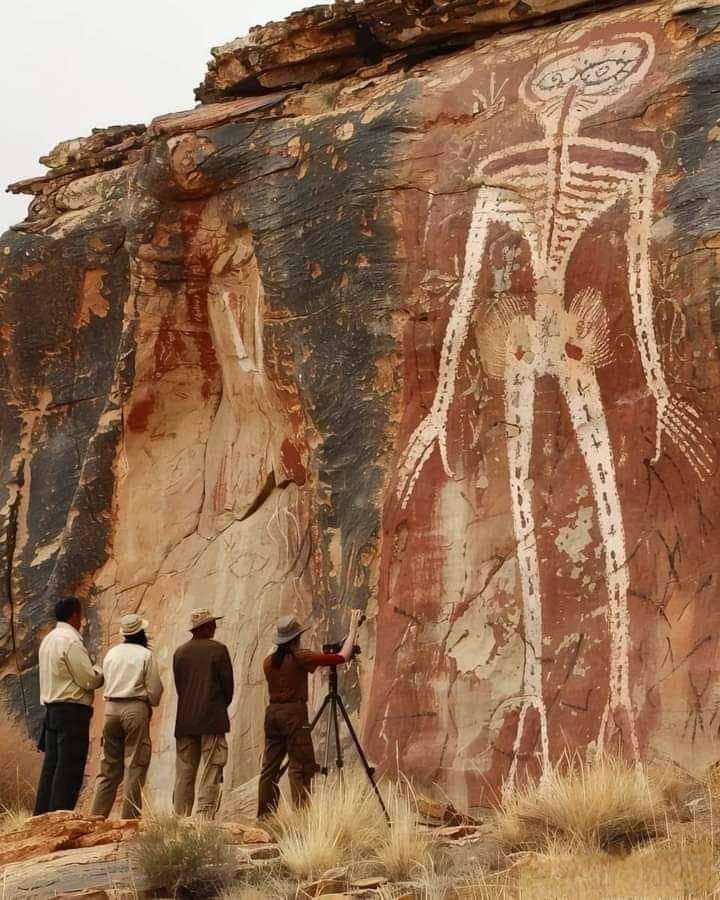🌌 Ancient Cave Paintings and the Myth of Alien Encounters in India 🌌
The ancient art and folklore of India have long captivated the imaginations of historians, archaeologists, and enthusiasts of mysteries alike. In the Hoshangabad district of Madhya Pradesh and the Charama area of Chhattisgarh, ancient rock and cave paintings dating back thousands of years hold stories waiting to be interpreted. But could these paintings hint at something beyond our world? Here’s a closer look at what’s fact and what’s myth.
🎨 The Art of Prehistoric India: India is home to some of the most significant prehistoric art, including the famous Bhimbetka rock shelters in Madhya Pradesh. These shelters, a UNESCO World Heritage site, showcase paintings that are over 10,000 years old. The artwork depicts scenes of daily life, hunting, and rituals, created using natural pigments that have remarkably stood the test of time.
In Chhattisgarh’s Charama region, similar rock paintings have been discovered, some of which have piqued the interest of those who believe in the possibility of ancient encounters with beings from other worlds. Among these artworks, certain figures appear to be humanoid shapes with unusual features, such as what some interpret as helmets or suits. Other elements have been described as resembling disc-shaped objects or formations that, to the modern eye, might suggest spacecraft.
👽 Alien Interpretations and the "Rohela People" Myth: Over the years, theories about these cave paintings have sparked conversations beyond the bounds of traditional archaeology. Some researchers and enthusiasts suggest that the paintings may represent extraterrestrial beings or UFOs. This interpretation aligns with the broader idea of the ancient astronaut hypothesis, which posits that extraterrestrial beings visited Earth in ancient times, influencing early human culture and development.
In local folklore, there are tales of beings called the "Rohela People," believed to be visitors from the stars. According to stories passed down through generations, these beings descended from the sky, taught the people new skills, shared wisdom, and then returned to their celestial homes. While these myths can be seen as echoes of human curiosity about the stars and the unknown, they also contribute to the intrigue surrounding the ancient art found in these regions.
🧠 Archaeological Perspectives: Mainstream archaeology tends to interpret these paintings within the context of religious or shamanistic practices. The ancient people may have depicted spirits, deities, or visionary experiences rather than literal extraterrestrial visitors. Symbols such as unusual figures or abstract shapes could represent human connections with the spiritual or supernatural rather than beings from outer space.
🔍 What Do We Really Know?: While the idea of ancient alien encounters is compelling and makes for fascinating discussion, it’s essential to approach these interpretations with a critical eye. The rock art in Hoshangabad and Charama is undoubtedly impressive and mysterious, but it is most commonly understood as part of the rich tapestry of human artistic and cultural expression. The ancient myths, like those of the "Rohela People," enrich the folklore and spiritual history of the region but are not regarded as evidence of extraterrestrial contact by the majority of scholars.
✨ Your Thoughts?: These ancient paintings and myths continue to stir our imaginations and remind us of humanity’s long-standing fascination with the cosmos. What do you think about these interpretations? Are they echoes of ancient beliefs and rituals, or could they hint at something more? Drop your thoughts below! ⬇️
#ancientart #cavepaintings #hoshangabad #charama #indianhistory #mythsandlegends #alientheories #archaeology #mysteriouspast #folklore
